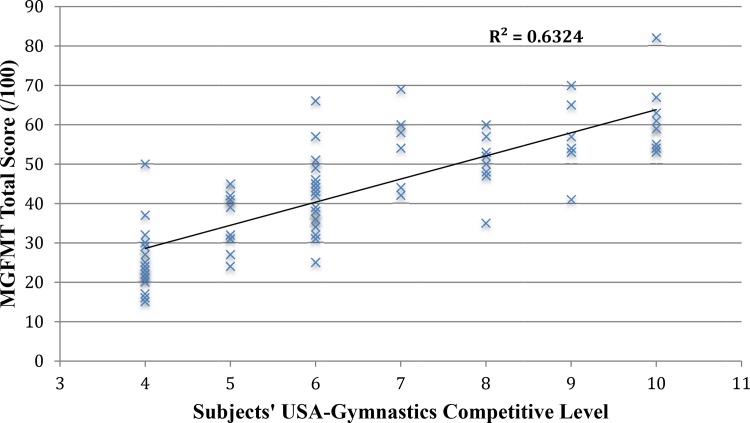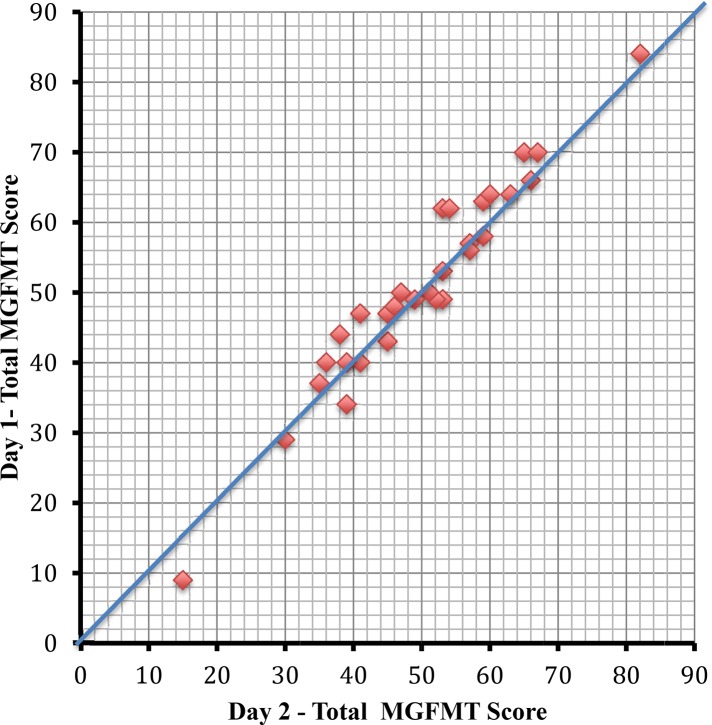Abstract
Purpose/Background
Despite the availability of various field-tests for many competitive sports, a reliable and valid test specifically developed for use in men's gymnastics has not yet been developed. The Men's Gymnastics Functional Measurement Tool (MGFMT) was designed to assess sport-specific physical abilities in male competitive gymnasts. The purpose of this study was to develop the MGFMT by establishing a scoring system for individual test items and to initiate the process of establishing test-retest reliability and construct validity.
Methods
A total of 83 competitive male gymnasts ages 7-18 underwent testing using the MGFMT. Thirty of these subjects underwent re-testing one week later in order to assess test-retest reliability. Construct validity was assessed using a simple regression analysis between total MGFMT scores and the gymnasts’ USA-Gymnastics competitive level to calculate the coefficient of determination (r2). Test-retest reliability was analyzed using Model 1 Intraclass correlation coefficients (ICC). Statistical significance was set at the p<0.05 level.
Results
The relationship between total MGFMT scores and subjects’ current USA-Gymnastics competitive level was found to be good (r2 = 0.63). Reliability testing of the MGFMT composite test score showed excellent test-retest reliability over a one-week period (ICC = 0.97). Test-retest reliability of the individual component tests ranged from good to excellent (ICC = 0.75-0.97).
Conclusions
The results of this study provide initial support for the construct validity and test-retest reliability of the MGFMT.
Level of Evidence
Level 3
Keywords: Functional measurement, gymnastics, physical abilities
INTRODUCTION
Five million young gymnasts, defined as being at least six years of age, participate in formal gymnastics related activities each year in the United States (US).1 While the vast majority of these young athletes are female, 25% (∼ 1.3 million) of the representative gymnastic athletes are young males. Approximately 12,000 of these young male gymnasts compete in the US Junior Olympic program while the remaining primarily participate in activities through the Amateur Athletic Union, the Young Men's Christian Association, and other organizations. In addition to these programs, the number of male gymnasts competing at the high school and collegiate levels in the US is reportedly on the rise.1
As opposed to the four events that comprise women's gymnastics, male gymnasts compete in six events: the floor exercise, pommel horse, vault, still rings, parallel bars, and horizontal bar (also known as the high bar). Flexibility,2-8 speed,6,9-11 power,7,8,12,13 strength,5,6,14,15 muscular endurance,14 agility,16 and balance17,18 have all been associated with competitive gymnastics and may also relate to a gymnast's ability to sustain injury-free and long-term participation in the sport.8,17,19 As such, it is imperative that coaches, athletic trainers, therapists, and other health care providers be able to objectively measure and monitor an individual gymnast's physical abilities as a means of promoting healthy, injury-free participation in the sport.
Within USA-Gymnastics, a system of competitive levels (ranging from a low of 4 to a high of 10) is used to rank the skills and abilities of individual gymnasts. Moving from one level to the next requires that a gymnast attain a specific all-around score as well as be able to perform specific gymnastics skills that increase in difficulty as the competitive level increases. Each increasing competitive level thus places increased demands on a gymnast in regards to higher levels of technical skill and mental acuity in tandem with increased levels of physical ability (e.g. strength, power, speed, flexibility, balance and agility).16
At the forefront of the USA-Gymnastics program is the need to identify talented young gymnasts for both individual and team level competition.20-25 Screening the available population for the best possible athletes however, has historically been based upon the opinion of “experts” in the sport with very little, if any, consideration of objective metrics.26 With an increasing push for excellence, national and international stakeholders in the sport have placed an increased emphasis on identifying individuals with the potential to become an elite-level gymnast. For example, through USA-Gymnastics, the US has instituted an extensive talent identification program for male gymnasts called Future Stars.25 Future Stars is designed exclusively for boys ages 8 to 13 and consists of selected gymnastics skills and compulsory routines plus strength and flexibility evaluations. It is used primarily with club gymnasts to identify competitive potential and to aid in the development of the US competitive gymnastics program and was not designed to assess the gymnastic-specific physical abilities of individual athletes. Future Stars also was not designed to address the needs of gymnasts of all ages or those who compete through high school or collegiate programs. While specialized training is needed to administer the Future Stars program, the reliability and validity of the Future Stars testing procedures have not been reported.
In contrast to screening for talent, field-testing is often used to assess an athlete's sport-related physical abilities.27-34 Some field-tests focus on a specific aspect of sports function (such as the hop test35 or the agility T-test36) while other tests, such as the Functional Movement Screen™,37,38 consist of a series of individual items designed to assess an athlete's abilities across multiple aspects of function. Sports-specific field-tests focus on assessing the specific physical abilities and attributes necessary for successful participation in a particular sport.24,27,29,30,34-36
Although establishing the reliability and validity of a tool is a multi-dimensional and on-going process, currently there is not a reliable and valid test to evaluate the sport-specific physical abilities needed for competition in men's gymnastics. Grabiner and McKelvain developed a physical fitness testing battery for male gymnasts, but did not report reliability or validity data.21 The recently developed Gymnastics Functional Measurement Tool (GFMT) has been shown to have good test-retest reliability and construct validity, but, it was only developed for female gymnasts.39 The Men's Gymnastics Functional Measurement Tool (MGFMT) was thus developed to allow coaches, athletic trainers, and other health professionals to measure a gymnast's overall physical abilities while minimizing the impact of gymnastic skill on testing scores.40,41 The individual test items included in the MGFMT (Table 1) were developed based on a set of criteria including: 1) the test item had to be easy to apply without requiring specialized equipment, 2) the test item had to reflect physical abilities inherent in male gymnastics skills and activities, 3) the test item had to be quantitative, 4) the test item had to measure flexibility, strength, power, agility or balance of one or multiple body segments and 5) the test item would not require a tester to have previous or current skills in gymnastics. All items on the MGFMT thus had to be able to be performed by a non-gymnast. Detailed information regarding administration of each test item is provided in Appendix I.
Table 1.
Individual Items Comprising the Men's Gymnastics Functional Measurement Tool
| Item | Targeted Area(s) of Fitness Assessment | Units of Measure for Raw Score |
|---|---|---|
| The Rings Hold Test | Should adductor strength and endurance | Distance (cm) from axilla/arm length (cm) |
| The Vertical Jump Test | Lower extremity power | Height jumped (cm) |
| The Hanging Pikes Test | Abdominal strength, hip flexor strength, and flexibility as well as grip strength | Number of repetitions |
| The Shoulder Flexibility Test | Shoulder complex flexion flexibility | Dowel height (cm) / arm length (cm) |
| The Agility Test | Speed, endurance, and agility | Seconds |
| The Overgrip Pull-up Test | Upper extremity strength and muscular endurance | Number of repetitions |
| The Splits Test | Pelvis and lower extremity flexibility | Sum of L, R, and middle split clearance (cm) / leg length (cm) |
| The Handstand Push-up Test | Shoulder and upper extremity strength and endurance | Number of repetitions |
| The Star Excursion Balance Test | Balance and muscular control | Sum of eight distances (cm) / leg length (cm) |
| The Handstand Test | Strength, endurance and balance | Seconds |
The purpose of this study was to develop a scoring system for the MGFMT (both for individual test items and for a composite score) and to begin the process of establishing the reliability and validity of the MGFMT.
METHODS
Approval for the study was obtained from the Office for the Protection of Research Subjects at Northwestern and Nova Southeastern Universities. Competitive male gymnasts were recruited from five different private gymnastics clubs throughout Illinois and Texas. Inclusion criteria required the subjects to be male, between 7 and 18 years of age, regularly practicing gymnastics three to six days per week, and competing in gymnastics at USA-Gymnastics levels 4 to 10. Exclusion criteria included musculoskeletal pathology currently limiting the gymnast's ability to train or compete; a history of, or current systemic illnesses including cardiovascular or pulmonary disease; musculoskeletal disease or rheumatoid arthritis; and a lack of informed assent given by the subject or consent given by the parent/legal guardian. The total number of gymnasts tested at each competitive level was based on a sample of convenience and thus the number of gymnasts tested at each level varied. A total of 83 subjects participated in the study. Figure 1 offers a flowchart reflecting subjects’ participation in the study.
Figure 1.
Flowchart of Subjects’ Participation in the Study.
All testing was performed in the subjects’ home gyms or in a gym familiar to the subject. Subjects did not have prior knowledge or exposure to the specific items composing the MGFMT. Each subject provided his own USA-Gymnastics competitive level, which was recorded by the testers. Prior to testing, subjects completed their regular, coach-directed warm-up routines without regard to the requirements of the MGFMT. Given that field-tests comprised of multiple items are often administered in stations each consisting of an individual item,40,41 subjects were placed into groups of 5-10 and moved through each of the stations to complete the MGFMT. Data were collected by gymnastics coaches with a minimum of five years of coaching experience, the principal investigator, and another licensed physical therapist with gymnastics experience. In an effort to simulate actual practice patterns, all data collectors were provided with a detailed set of instructions for administering each item on the MGFMT but did not undergo any specialized or extensive training. The principal investigator observed initial data collection to confirm testing was done correctly. Raw data for each item of the MGFMT was recorded in units of measurement that were appropriate for the activity. Units of measurement for the raw data for each test item are listed in Table 1. Subjects were not intentionally masked as to their item scores. Individual MGFMT items were completed in the following order to help reduce the possible effects of regional fatigue: Hanging Pikes Test, Rings Hold Test, Vertical Jump Test, Shoulder Flexibility Test, Handstand Pushups Tests, Agility Test, Star Excursion Balance Test, Handstand Hold Test, Overgrip Pull-ups Test, and the Splits Test. Subjects were given a minimum of five and a maximum of 15 minutes rest between administrations of each item of the MGFMT.
From the 83 total subjects, a random convenience sample of 30 subjects from two gymnastics clubs in Illinois was chosen to participate in test-retest reliability testing. These 30 subjects were retested with the MGFMT one week after initial testing. Testing conditions and administration were consistent between the two administrations of the MGFMT including warm-up and item administration order. To help ensure that test-retest reliability rather than intra-rater reliability was assessed, testers administered different items from the MGFMT on each of the two administration dates.
Statistical Methods
Development of the Scoring System
The scoring system for the MGFMT was developed utilizing the same method used to develop the scoring system for the GFMT. Raw test item scores in the appropriate units of measurement were recorded for each of the individual test items. These raw scores were used to calculate the range, mean, and standard deviation for each individual item of the MGFMT (n = 83). Data was then transformed to an ordinal scale. In an attempt to reduce the possibility of ceiling and floor effects, five percent of the total range of the raw scores was added to the high score of each item and five percent was subtracted from the low score of each item. The resulting range of scores for each individual item was then divided by 11 to create a 0 to 10 ordinal scale for each individual item on the MGFMT.39 The ordinal scale for each item was used to create a total MGFMT score out of a possible 100 points (10 points for each item). Based on these findings, the scoring for each individual item and for the total MGFMT score were finalized and are provided in the MGFMT Score Sheet found in Appendix II.
Test-retest and Construct Validity
Test-retest reliability was analyzed using Model 1 Intra-class correlation coefficients (ICC).42 Although a process of systematic randomization was not employed in the study, a Model 1 ICC was used to reflect the concept that individual items on the MGFMT were administered on each of the two test dates. The variance assessed was thus restricted to differences in the subjects’ scores in the test-retest design and necessitated the use of a Model 1 ICC. Values for the ICC were interpreted according to these levels of agreement: ‘poor to moderate’ = 0.00-0.75, ‘good’ = 0.75-0.90 and ‘excellent’ = 0.90-1.00.42,43 In an effort to better graphically represent the test re-test reliability, comparisons of agreement between test day one and test day two were analyzed using a Lin's Concordance Correlation (LCC) Coefficient (pc). Ranging between 1 (perfect agreement) and -1 (perfect inverse agreement), pc represents the extent to which the compared data deviate significantly from perfect concordance.44
Given previously reported positive relationships between various singular physical abilities and a gymnast's level of competition with the GFMT,10,14,21,39 it was theorized that the total scores on the MGFMT would vary with a gymnast's current competitive level. This was based upon the concept that at each increasing competitive level, a gymnast is required to perform increasingly difficult skills that theoretically would require a related increase in the gymnast's physical abilities. In addition, the competitive level of female gymnasts was used in the construct validation process for the GFMT developed for use with female gymnasts.39 Construct validity was thus evaluated based on the relationship between a gymnast's physical abilities as measured by the MGFMT and the gymnast's current level of competition as reflected by the gymnast's USA-Gymnastics competitive level. A linear regression analysis was performed using a gymnast's USA- Gymnastics competitive level to predict total MGFMT score. The coefficient of determination (r2) was used to explore this relationship. Statistical significance was set at α = 0.05 level.
RESULTS
Of the 105 subjects assessed for eligibility in this study, 83 participated. Twenty-two of the recruited subjects were excluded from the study due to recent injury (n = 4) or the lack of a signed informed consent or assent (n = 18). The number of subjects representing each competitive level ranged from 6-20. The mean age of participating subjects was 11.07 (range – 7-18) years with these subjects reporting participation in competitive gymnastics for a mean of 4.36 (range 1-13) years. The mean reported number of hours spent practicing was 8.5 for level 4 gymnasts and 21.4 for level 10 gymnasts. Subject demographics, categorized by USA-Gymnastics competition level, are summarized in Table 2. Mean MGFMT component test item raw scores and standard deviations are presented in Table 3.
Table 2.
Subject Demographics by USA-Gymnastics Competitive Level
| Competition Level | 4 | 5 | 6 | 7 | 8 | 9 | 10 | All Subjects |
|---|---|---|---|---|---|---|---|---|
| Number of Subjects | 20 | 12 | 20 | 7 | 8 | 6 | 10 | 83 |
| Mean Age in Years (sd) | 8.3 (1.3) | 9.2 (1.3) | 10.6 (1.6) | 12.3 (0.8) | 13.3 (1.7) | 12.8 (0.8) | 16.2 (1.1) | 11.1 (2.9) |
| Mean Years Competing | 1.4 | 2.7 | 4.4 | 5.14 | 5.7 | 6.7 | 9.5 | 4.4 (2.9) |
| Mean Reported Number of Hours Practicing per Week | 8.5 | 10.7 | 14.5 | 20.8 | 17.7 | 18.7 | 21.4 | 14.5 (5.4) |
| Mean Height in cm (sd) | 129 (9.9) | 135 (9.3) | 142 (12.8) | 149 (7.6) | 154 (15.4) | 149 (4.9) | 163.8 (3.8) | 142.8 (15.0) |
| Mean Weight in kg (sd) | 28.2 (6.4) | 29.7 (6.1) | 35.1 (8.1) | 39.5 (4.8) | 48.8 (14.9) | 43.1 (5.3) | 56.6 (4.2) | 82.9 (26.5) |
sd = Standard Deviation, cm = Centimeters, kg = Kilograms
Table 3.
Mean and Standard Deviation of MGFMT Individual Item Scores and Total Men's Gymnastics Functional Measurement Tool Scores (n = 83)
|
Splits Test (combined [cm/leg length]) Mean (sd) |
Shoulder Flexibility Test (cm/arm length) Mean (sd) |
Hanging Pikes Test (reps) Mean (sd) |
Overgrip Pull-ups Test (reps) Mean (sd) |
Handstand Push-up Test (reps) Mean (sd) |
Rings Hold
(Cm from axilla/cm arm length) Mean (sd) |
Agility Test (secs) Mean (sd) |
Vertical Jump Test (cm) Mean (sd) |
Star Excursion Balance Test (total distance/leg length *100) Mean (sd) |
Handstand Hold Test (secs) Mean (sd) |
Total MGFMT Score | |
|---|---|---|---|---|---|---|---|---|---|---|---|
| Total sample (Levels 4 -10) | 0.55 (0.35) | 0.55 (0.19) | 17.8 (10.3) | 9.2 (5.5) | 6.8 (7.2) | 0.39 (0.13) | 19.84 (2.1) | 40.4 (11.3) | 767 (89.5) | 34.5 (35.5) | 42.4 (14.9) |
| Level 4 scores | 0.62 (0.28) | 0.46 (0.16) | 11.4 (6.8) | 4.2 (4.3) | 3.0 (4.3) | 0.28 (0.1) | 22.13 (1.8) | 29.6 (6.4) | 696 (109) | 7.7 (14.6) | 25.2 (8.0) |
| Level 5 scores | 0.54 (0.17) | 0.56 (0.12) | 13.9 (7.1) | 6.8 (2.2) | 4.17 (3.3) | 0.38 (0.11) | 20.5 (1.3) | 34.6 (6.6) | 777 (70.9) | 19.7 (19.4) | 36.7 (7.1) |
| Level 6 scores | 0.49 (0.32) | 0.61 (0.22) | 15.8 (9.0) | 8.6 (3.6) | 7.10 (7.4) | 0.35 (0.07) | 19.9 (1.2) | 38.0 (6.8) | 793 (53.9) | 29.9 (28.7) | 41.9 (9.6) |
| Level 7 scores | 0.23 (0.7) | 0.67 (0.31 | 20.9 (11.4) | 12.0 (3.3) | 6.29 (5.9) | 0.54 (0.07) | 18.9 (1.53) | 48.9 (8.4) | 815 (82.2) | 46.6 (47.0) | 57.5 (9.5) |
| Level 8 scores | 0.62 (0.21) | 0.61 (0.11) | 25.1 (8.1) | 12.9 (5.6) | 6.75 (5.2) | 0.44 (0.12) | 18.1 (0.7) | 46.8 (8.3) | 777 (90.4) | 37.8 (30.9) | 50.2 (7.6) |
| Level 9 scores | 0.42 (0.22) | 0.64 (0.11) | 27.2 (9.1) | 13.3 (4.0) | 9.5 (9.1) | 0.46 (0.11) | 17.8 (1.1) | 49.0 (5.2) | 759 (75.1) | 76.0 (32.0) | 56.7 (10.1) |
| Level 10 scores | 0.80 (0.38) | 0.45 (0.11) | 25.4 (12.7) | 15.9 (4.1) | 15.7 (8.8) | 0.54 (0.15) | 17.7 (1.3) | 57.5 (5.5) | 809 (70.5) | 78.7 (26.6) | 60.8 (8.7) |
sd = Standard Deviation, cm = Centimeters, kg = Kilograms, secs = Seconds, deg = Degrees, reps = Repetitions,
Raw scores for all items on the MGFMT demonstrated a normal distribution (skewness = [−]0.56 – [+]1.51). The relationship between the individual component test item raw scores of the MGFMT as well as with the MGFMT total-score and subjects’ current USA-Gymnastics competitive level was evaluated and can be seen in Table 4. Several of the relationships between the individual component raw scores were statistically significant, however, r2 values revealed poor to good relationships between USA-Gymnastics competitive level and individual component raw scores (r2 = 0.004-0.64). The relationship between MGFMT total-scores (out of a possible score of 100) and the subjects’ current USA-Gymnastics competitive level was found to be good (r2 = 0.63) and can be observed graphically in Figures 2 and 3. To rule out alternative explanations for the relationship between USA-Gymnastics competitive level and MGFMT total-scores, the relationships between MGFMT total-scores and age, MGFMT total-scores and bodyweight as well as MGFMT total-score and hours of training per week were also explored. Statistically significant relationships were identified between MGFMT total-score and age (r2 = 0.48), between MGFMT total-score and bodyweight (r2 = 0.30) and between MGFMT total-score and hours of training per week (r2 = 0.56).
Table 4.
Relationship between Men's Gymnastics Functional Measurement Tool (MGFMT) Individual Item Raw Score and Total MGFMT Score and the Subjects’ Current USA-Gymnastics Competitive Level, Age, and Body Weight (n = 83)
| Splits Test | Shoulder Flexibility Test | Hanging Pikes Test | Overgrip Pull-ups Test | Handstand Push-up Test | Rings Hold Test | Agility Test | Vertical Jump Test | Star Excursion Balance Test | Handstand Hold Test | Total MGFMT Score | |
|---|---|---|---|---|---|---|---|---|---|---|---|
| Test score vs. Competitive Level | 0.004 | 0.01 | 0.29* | 0.51* | 0.24* | 0.36* | 0.55* | 0.64* | 0.10* | 0.44* | 0.63* |
| Test score vs. Hours of Training per Week | 0.003 | 0.02 | 0.21* | 0.43* | 0.26* | 0.313* | 0.36* | 0.49* | 0.07* | 0.38* | 0.56* |
| Test score vs. Age | 0.004 | 0.002 | 0.12* | 0.42* | 0.41* | 0.16* | 0.51* | 0.61* | 0.07* | 0.26* | 0.48* |
| Test score vs. Body Weight (kg) | 0.03 | 0.001 | 0.05* | 0.25* | 0.06* | 0.35* | 0.47* | 0.57* | 0.04 | 0.17* | 0.30* |
Values expressed in terms of Coefficient of Determination (r2)
Denotes statistically significant relationship (p<.05)
Figure 2.
The Relationship between the Men's Gymnastics Functional Measurement Tool (MGFMT) Total Score and Subjects’ USA-Gymnastics Competitive Level.
Figure 3.
Lin Concordance Coefficient Correlation for Test-retest Reliability of the Men's Gymnastics Functional Measurement Tool (MGFMT) Total Score
Raw item scores were used to examine the test-retest reliability for each item on the MGFMT. Test-retest reliability of total MGFMT scores was also determined. Reliability testing of the MGFMT total score showed good test-retest reliability over a one-week period (ICC = 0.97). Test-retest reliability coefficients are shown in Table 5. A statistically significant difference (p<0.05) between the first and second test scores was identified for the MGFMT Total score and for the following test items: Hanging Pikes Test, Agility Test, Vertical Jump Test, Start Excursion Balance Test. Test-retest reliability of the individual component items was good (ICC = 0.70-0.92). Test-retest reliability testing of the MGFMT total-score showed excellent test-retest reliability over a one-week period (ICC = 0.97).
Table 5.
Score Means and Standard Deviations for Both Test Days and Intraclass Correlation Coefficients for Test Retest Reliability (n = 30)
|
Splits Test (combined [cm/leg length]) Mean (sd) |
Shoulder Flexibility Test (cm/arm length) Mean (sd) |
Hanging Pikes Test (reps) Mean (sd) |
Overgrip Pull-ups Test (reps) Mean (sd) |
Handstand Push-up Test (reps) Mean (sd) |
Rings Hold (Cm from axilla/ cm arm length) Mean (sd) |
Agility Test (secs) Mean (sd) |
Vertical Jump Test (cm) Mean (sd) |
Star Excursion Balance Test (total distance/leg length *100) Mean (sd) |
Handstand Hold Test (secs) Mean (sd) |
Total MGFMT 10-test Score (/100) Mean (sd) |
|
|---|---|---|---|---|---|---|---|---|---|---|---|
| Test Day 1 scores | 0.60 (0.33) | 0.58 (0.17) | 22.53 (8.7) | 11.5 (5.7) | 9.93 (9.1) | 0.42 (0.13) | 18.8 (1.91) | 46.9 (10.3) | 780 (80.3) | 46.89 (36.9) | 49.9 (13.2) |
| Test Day 2 scores | 0.59 (0.32) | 0.58 (0.15) | 23.27* (9.6) | 11.1 (6.1) | 9.10 (9.0) | 0.46* (0.12) | 19.1* (2.18) | 50* (12.3) | 810* (82.1) | 47.0 (41.4) | 51.1* (14.5) |
| Test re-test reliability ICC ** | 0.97 | 0.90 | 0.83 | 0.89 | 0.96 | 0.75 | 0.95 | 0.91 | 0.77 | 0.91 | 0.97 |
- * Signifies statistically significant difference from Test Day 1 scores (p<0.05)
- ** All reliability ICC scores were statistically significant (p<0.001)
DISCUSSION
The MGFMT is a functional tool designed to assess the unique physical abilities that are necessary for participation in men's gymnastics. The procedures and methods used in this study allowed the researchers to evaluate the MGFMT within the context of its intended use as a field test to assess sport-specific physical performance characteristics of male gymnasts.40,41 As such, testing was conducted in a manner consistent with the sport in an environment familiar to the individual athletes. Given that the MGFMT can be administered without extensive training using equipment readily available in a gymnastics gym, the authors believe that the MGFMT can be easily incorporated into any gymnastics program.
An improved ability to accurately measure strength, power, speed, balance, flexibility, and agility may assist in identifying and remediating deficits in the physical performance characteristics needed by male competitive gymnasts.17 In his comprehensive analysis, Sands19 suggested that a gymnast routinely and repeatedly performs difficult skills but may not possess the overall physical abilities and fitness levels necessary for prolonged, successful participation in the sport.11 In competitive gymnastics, an annual injury rate as high as 294% in male and female club gymnasts in the United States has been reported.45-47 Using the MGFMT to identify deficits in sport-specific physical abilities that can be targeted as part of a gymnast's individual training regime may prove useful in injury prevention. Future studies should explore use of the MGFMT to identify and remediate injury risk in male gymnasts.
The results of this study provide initial support for the construct validity and test-retest reliability of the MGFMT. Although construct validity is only one of the many forms of validity to be considered when evaluating a measurement tool,42,48 the relationship between a gymnast's total MGFMT score and current USA-Gymnastics competitive level provides support for the concept that like the GFMT, MGFMT scores will vary based on a gymnast's current competitive level. Examining data from the individual items comprising the MGFMT reveals that certain physical attributes such as power appear to relate more strongly to a gymnast's current competitive level than flexibility. Despite the variations in the strength of the relationship between individual items and competitive level, the authors believe that to completely assess a gymnast's physical abilities across multiple domain areas (strength, flexibility, power, etc.), all items on the MGFMT must be administered. Maintaining the complete representation of gymnastics specific physical abilities within the MGFMT is necessary in order to adequately identify a gymnast's deficits in physical abilities and may aid in the development of a program tailored to address individual needs.
This study was limited by several factors. The total number of participants at any given USA-Gymnastics competitive level ranged from 9 to 21. Increasing the number of participants at each USA-Gymnastics competitive level may have yielded different results. While attempts were made in the test-retest procedures to decrease the possibility of a practice or learning effect, the authors’ recognize that such factors may have impacted score differences between the first and second administrations of the MGFMT. In addition, the participants included in the study were from a limited number of gymnastics clubs in two specific States: Illinois and Texas. The outcomes of this research also may have been impacted by the training practices routinely performed in these two geographic areas.
Further research is needed to continue the process of establishing the various types of reliability and validity of the MGFMT. Future studies should also explore the ability of the MGFMT total score and individual item scores to identify a gymnast's risk for specific injuries and whether the MGFMT could be used to help determine if and when an injured gymnast can safely resume high-level training and competition.
CONCLUSION
While it is well understood that participation in the sport of gymnastics exposes the athlete to a significant risk of injury, there appears to be a direct relationship between the competitive level at which a gymnast competes and the occurrence as well as the type of injury that is most likely to occur.45,49 However, attempting to reduce the injury rate in competitive men's gymnastics is a very complex multifaceted endeavor. The establishment of a gymnastics-specific field test, which assesses the physical abilities of male gymnasts, is a first step in a myriad of possible solutions. The information gained through use of the MGFMT may assist coaches and healthcare providers in identifying and subsequently improving the physical abilities of competitive male gymnasts across the globe.
APPENDIX I.
Instructions for Administration of the MGFMT
| BRIEF DESCRIPTION | ||
|---|---|---|
| Rings Hold Test |
|
 |
| Handstand Pushup Test |
|
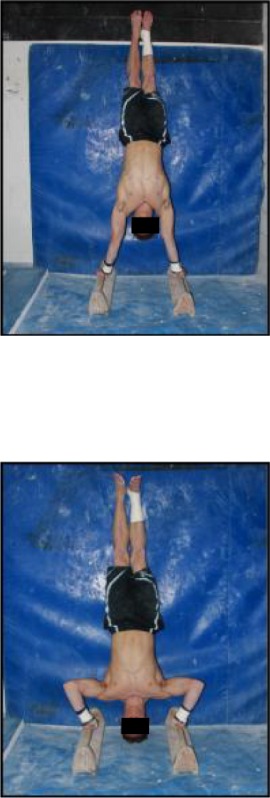 |
| Star Excursion Balance Test |
|
 |
| Overgrip Pull-ups Test |
|
 |
| Vertical Jump Test |
|
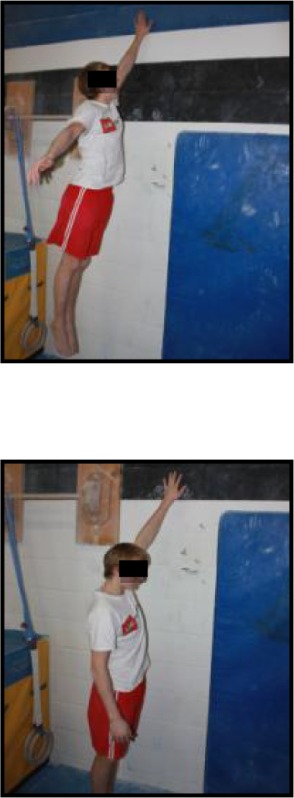 |
| Hanging Pikes |
|
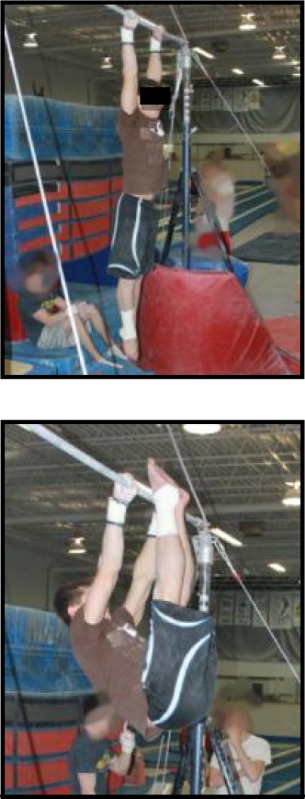 |
| Shoulder Flexibility Test |
|
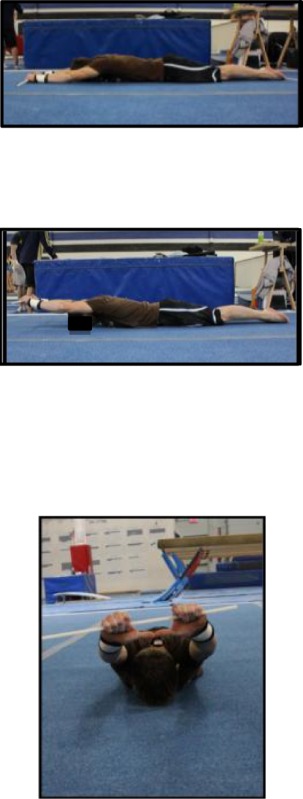 |
| Splits Tests |
|
 |
| Agility Test |
|
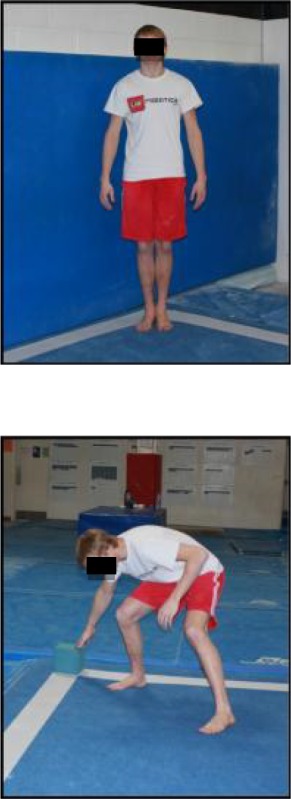 |
| Handstand Test |
|
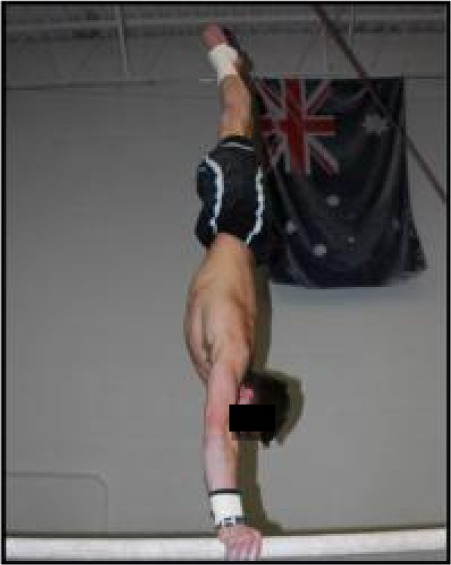 |
APPENDIX II.
Men's Gymnastics Functional Measurement Tool (MGFMT)
REFERENCES
- 1.USA-Gymnastics. USA Gymnastics Demographics. https://usagym.org/pages/aboutus/pages/demographics.html?prog=pb. Accessed November 3, 2016.
- 2.Kirby RL, Simms FC, Symington VJ, Garner JB. Flexibility and musculoskeletal symptomatology in female gymnasts and age-matched controls. Am J Sports Med. 1981;9(3):160-164. [DOI] [PubMed] [Google Scholar]
- 3.Knapik JJ, Bauman CL, Jones BH, Harris JM, Vaughan L. Preseason strength and flexibility imbalances associated with athletic injuries in female collegiate athletes. Am J Sports Med. 1991;19(1):76-81. [DOI] [PubMed] [Google Scholar]
- 4.Knapik JJ, Jones BH, Bauman CL, Harris JM. Strength, flexibility and athletic injuries. Sports Med. 1992;14(5):277-288. [DOI] [PubMed] [Google Scholar]
- 5.Maffulli N, King JB, Helms P. Training in elite young athletes (the Training of Young Athletes (TOYA) Study): injuries, flexibility and isometric strength. Br J Sports Med. 1994;28(2):123-136. [DOI] [PMC free article] [PubMed] [Google Scholar]
- 6.Nelson JK, Johnson BL, Smith GC. Physical characteristics, hip flexibility and arm strength of female gymnasts classified by intensity of training across age. J Sports Med Phys Fitness. 1983;23(1):95-101. [PubMed] [Google Scholar]
- 7.Delas S, Babin J, Katic R. Effects of biomotor structures on performance of competitive gymnastics elements in elementary school female sixth-graders. Coll Antropol. 2007;31(4):979-985. [PubMed] [Google Scholar]
- 8.Delas S, Zagorac N, Katic R. Effects of biomotor structures on performance of competitive gymnastics elements in elementary school male sixth-graders. Coll Antropol. 2008;32(2):443-449. [PubMed] [Google Scholar]
- 9.Bradshaw E. Target-directed running in gymnastics: a preliminary exploration of vaulting. Sports Biomech. 2004;3(1):125-144. [DOI] [PubMed] [Google Scholar]
- 10.Lindner KJ, Caine DJ, Johns DP. Withdrawal predictors among physical and performance characteristics of female competitive gymnasts. J Sports Sci. 1991;9(3):259-272. [DOI] [PubMed] [Google Scholar]
- 11.Sands B, Caine DJ, Borms J. Scientific aspects of women's gymnastics. Basel ; New York: Karger; 2003. [Google Scholar]
- 12.Bencke J, Damsgaard R, Saekmose A, Jorgensen P, Jorgensen K, Klausen K. Anaerobic power and muscle strength characteristics of 11 years old elite and non-elite boys and girls from gymnastics, team handball, tennis and swimming. Scand J Med Sci Sports. 2002;12(3):171-178. [DOI] [PubMed] [Google Scholar]
- 13.Jemni M, Sands WA, Friemel F, Stone MH, Cooke CB. Any effect of gymnastics training on upper-body and lower-body aerobic and power components in national and international male gymnasts? J Strength Cond Res. 2006;20(4):899-907. [DOI] [PubMed] [Google Scholar]
- 14.Bradshaw EJ, Le Rossignol P. Anthropometric and biomechanical field measures of floor and vault ability in 8 to 14 year old talent-selected gymnasts. Sports Biomech. 2004;3(2):249-262. [DOI] [PubMed] [Google Scholar]
- 15.Faria IE, Faria EW. Relationship of the anthropometric and physical characteristics of male junior gymnasts to performance. J Sports Med Phys Fitness. 1989;29(4):369-378. [PubMed] [Google Scholar]
- 16.Daly RM, Bass SL, Finch CF. Balancing the risk of injury to gymnasts: how effective are the counter measures? Br J Sports Med. 2001;35(1):8-18; quiz 19. [DOI] [PMC free article] [PubMed] [Google Scholar]
- 17.Lindner K, Caine D. Injury predictors among female gymnasts’anthropometric and performance characteristics. In: Hermans G Mosterd W, eds. Sports, Medicine and Health. Amsterdam: Excerpta Medica; 1990:136–141. [Google Scholar]
- 18.Peltenburg AL, Erich WB, Bernink MJ, Huisveld IA. Selection of talented female gymnasts, aged 8 to 11, on the basis of motor abilities with special reference to balance: a retrospective study. Int J Sports Med. 1982;3(1):37-42. [DOI] [PubMed] [Google Scholar]
- 19.Sands WA. Injury prevention in women's gymnastics. Sports Med. 2000;30(5):359-373. [DOI] [PubMed] [Google Scholar]
- 20.Bajin B. Talent Identification Program for Canadian Female Gymnasts. In: Petiot B Salmela JH Hoshizaki TB, eds. World Indentification Systems for Gymnastic Talent. Montreal: Sports Psyche Editions; 1987. [Google Scholar]
- 21.Grabinar MD, McKelvain R. Implementation of a Profiling/Prediction Test Battery in the Screening of Elite Men Gymnasts. In: Petiot B Salmela JH Hoshizaki TB, eds. World Indentification Systems for Gymnastic Talent. Montreal: Sports Psyche Editions; 1987. [Google Scholar]
- 22.Ho R. Talent Indentification in China. In: Petiot B Salmela JH Hoshizaki TB, eds. World Indentification Systems for Gymnastic Talent. Montreal: Sports Psyche Editions; 1987. [Google Scholar]
- 23.Sands WA. Olympic Preporation Camps 2000 - Physical Ability Testing. Technique. 2000;20(10):6-19. [Google Scholar]
- 24.Sleeper M, Kenyon L, Casey E. Measuring Fitness in Female Gymnasts: The Gymnastics Functional Measurement Tool. International Journal of Sports Physical Therapy. 2012;7(2):124-138. [PMC free article] [PubMed] [Google Scholar]
- 25.USA-Gymnastics. Men's Future Stars Program Overview. 2009; https://usagym.org/PDFs/Men/FutureStars/FutureStarsRoutines.pdf. Accessed January 8, 2015.
- 26.Regnier G, Salmela HH. Predictors of Success in Canadian Male Gymnasts. In: Petiot B Salmela JH Hoshizaki TB, eds. World Indentification Systems for Gymnastic Talent. Montreal: Sports Psyche Editions; 1987. [Google Scholar]
- 27.Alves CR, Borelli MT, Paineli Vde S, et al. Development of a specific anaerobic field test for aerobic gymnastics. PloS one. 2015;10(4):e0123115. [DOI] [PMC free article] [PubMed] [Google Scholar]
- 28.Uljevic O, Esco MR, Sekulic D. Reliability, validity, and applicability of isolated and combined sport-specific tests of conditioning capacities in top-level junior water polo athletes. J Strength Cond Res. 2014;28(6):1595-1605. [DOI] [PubMed] [Google Scholar]
- 29.Uljevic O, Spasic M, Sekulic D. Sport-specific motor fitness tests in water polo: reliability, validity and playing position differences. Journal of sports science & medicine. 2013;12(4):646-654. [PMC free article] [PubMed] [Google Scholar]
- 30.Keogh JW, Weber CL, Dalton CT. Evaluation of anthropometric, physiological, and skill-related tests for talent identification in female field hockey. Can J Appl Physiol. 2003;28(3):397-409. [DOI] [PubMed] [Google Scholar]
- 31.Mohamed H, Vaeyens R, Matthys S, et al. Anthropometric and performance measures for the development of a talent detection and identification model in youth handball. J Sports Sci. 2009;27(3):257-266. [DOI] [PubMed] [Google Scholar]
- 32.Pearson DT, Naughton GA, Torode M. Predictability of physiological testing and the role of maturation in talent identification for adolescent team sports. J Sci Med Sport. 2006;9(4):277-287. [DOI] [PubMed] [Google Scholar]
- 33.Reilly T, Williams AM, Nevill A, Franks A. A multidisciplinary approach to talent identification in soccer. J Sports Sci. 2000;18(9):695-702. [DOI] [PubMed] [Google Scholar]
- 34.Williams AM, Reilly T. Talent identification and development in soccer. J Sports Sci. 2000;18(9):657-667. [DOI] [PubMed] [Google Scholar]
- 35.Myers BA, Jenkins WL, Killian C, Rundquist P. Normative data for hop tests in high school and collegiate basketball and soccer players. Int J Sports Phys Ther. 2014;9(5):596-603. [PMC free article] [PubMed] [Google Scholar]
- 36.Schaal M, Ransdell LB, Simonson SR, Gao Y. Physiologic performance test differences in female volleyball athletes by competition level and player position. J Strength Cond Res. 2013;27(7):1841-1850. [DOI] [PubMed] [Google Scholar]
- 37.Lockie R, Schultz A, Callaghan S, Jordan C, Luczo T, Jeffriess M. A preliminary investigation into the relationship between functional movement screen scores and athletic physical performance in female team sport athletes. Biology of sport. 2015;32(1):41-51. [DOI] [PMC free article] [PubMed] [Google Scholar]
- 38.Bardenett SM, Micca JJ, DeNoyelles JT, Miller SD, Jenk DT, Brooks GS. Functional Movement Screen Normative Values and Validity in High School Athletes: Can the Fms Be Used as a Predictor of Injury? Int J Sports Phys Ther. 2015;10(3):303-308. [PMC free article] [PubMed] [Google Scholar]
- 39.Sleeper MD, Kenyon LK, Casey E. Measuring fitness in female gymnasts: the gymnastics functional measurement tool. Int J Sports Phys Ther. 2012;7(2):124-138. [PMC free article] [PubMed] [Google Scholar]
- 40.Sleeper M, Beers M, Erwin M, et al. The Gymnastics Functional Measurement Tool: An Instrument for the Physical Assessment of Competitive Gymnasts. Paper presented at: American College of Sports Medicine2006; Denver, CO. [Google Scholar]
- 41.Sleeper M, Casey E. The Gymnastics Functional Measurement Tool: A Valid way of Measuring Gymnastics Physical Abilities. Paper presented at: American Physical Therapy Association Combined Sections Meeting2010; San Diego, CA. [Google Scholar]
- 42.Portney L, Watkins M. Foundations of Clinical Research: Applications to Practice. third ed. Upper Saddle River, NJ: Pearson/Prentice Hall; 2009. [Google Scholar]
- 43.Cicchetti DV. The precision of reliability and validity estimates re-visited: distinguishing between clinical and statistical significance of sample size requirements. Journal of clinical and experimental neuropsychology. 2001;23(5):695-700. [DOI] [PubMed] [Google Scholar]
- 44.Mirandola M, Bisoffi G, Bonizzato P, Amaddeo F. Collecting psychiatric resources utilisation data to calculate costs of care: a comparison between a service receipt interview and a case register. Social psychiatry and psychiatric epidemiology. 1999;34(10):541-547. [DOI] [PubMed] [Google Scholar]
- 45.Caine D, Knutzen K, Howe W, et al. A three-year epidemiological study of injuries affecting young female gymnasts. Phys Therap Sport. 2003;4:10-23. [Google Scholar]
- 46.Dixon M, Fricker P. Injuries to elite gymnasts over 10 yr. Med Sci Sports Exerc. 1993;25(12):1322-1329. [PubMed] [Google Scholar]
- 47.Kerr G. Injuries in Artistic Gymnastics. J Cdn Athlet Therap Assoc. 1991(April):19-21. [Google Scholar]
- 48.Sechrest L. Validity of measures is no simple matter. Health Serv Res. 2005;40(5 Pt 2):1584-1604. [DOI] [PMC free article] [PubMed] [Google Scholar]
- 49.Caine D, Cochrane B, Caine C, Zemper E. An epidemiologic investigation of injuries affecting young competitive female gymnasts. Am J Sports Med. 1989;17(6):811-820. [DOI] [PubMed] [Google Scholar]




